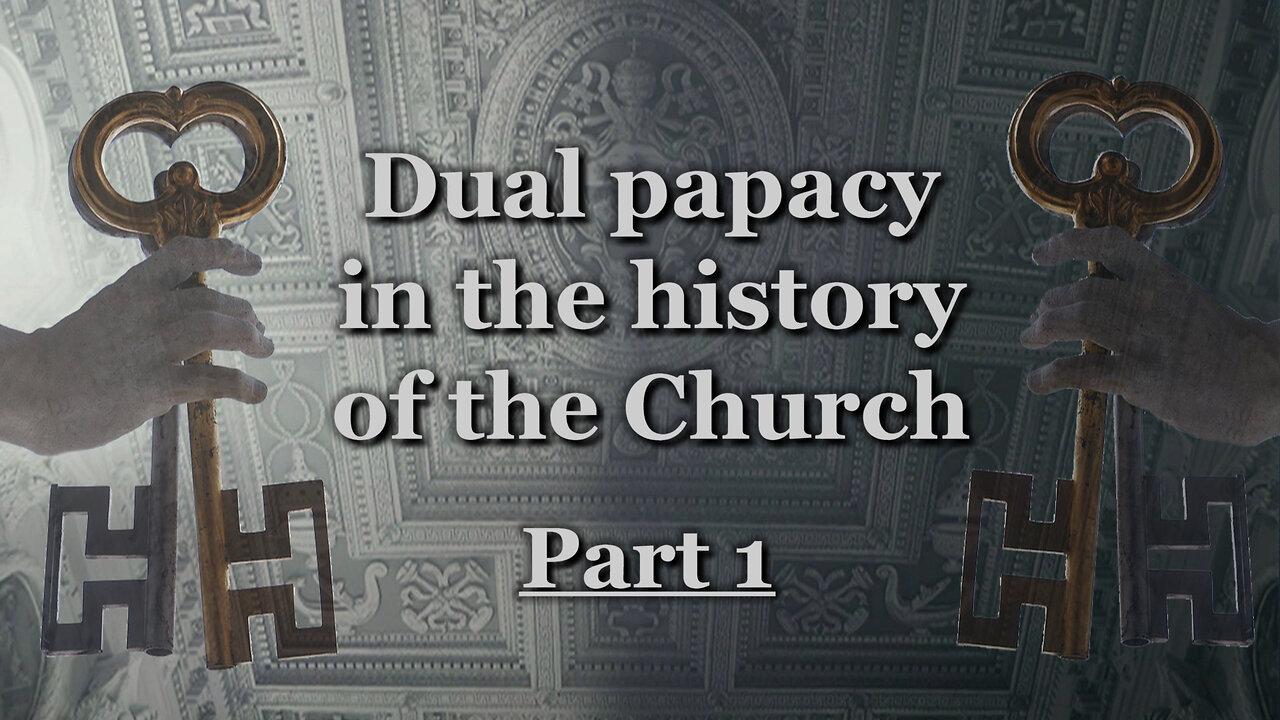Premium Only Content

Dual papacy in the history of the Church /Part 1/
Watch this video on: https://decisive-step.wistia.com/medias/a3rm6czi0d
https://cos.tv/videos/play/46975455433888768
https://www.bitchute.com/video/AHaxexVK79U5/
https://ugetube.com/watch/koPoSGG4d2p6I1C
https://vkpatriarhat.org/en/?p=23479
https://bcp-video.org/dual-papacy-part-1/
Subscribe to BCP newsletters https://bit.ly/3cJLzzm
What is the point of reflecting back on dual papacy in the history of the Church? The point is to look for a solution in the present insoluble situation. Pseudo Pope Francis Bergoglio has brought on himself a multiple anathema – excommunication, that is, expulsion from the Church for destroying all the foundations of faith given to us by Scripture and Tradition. It is necessary in this extraordinary situation to seek and use extraordinary means to prevent the greatest catastrophe in church history from reaching its climax.
In this first part, we will recall the cases of dual papacy until the 11th century, that is, until the Cluniac reform. The dual papacy began already during the cruel persecution of the Church in the 3rd century.
3rd century
Callistus I (217‒222) – After the election of Pope Callistus, Hippolytus was soon ordained as Bishop of Rome. Hippolytus fought against the heresy of Sabellius denying the truth of the Holy Trinity.
Urban (222‒230) – Hippolytus was still ruling as a rival pope in this period.
Pontian (230‒235) – Hippolytus also continued to be pope under Pontian. For religious disputes, the prefect banished both Hippolytus and Pontian from Rome. Both renounced the papacy.
Cornelius (251‒253) – After the election of Cornelius, a certain part of the Roman community elected the Roman theologian Novatian as antipope.
4th century
Liberius (352‒366) – Liberius was exiled to Thrace by Emperor Constantine, who was promoting Arianism at the time. Archdeacon Felix (355‒358) was installed as Bishop of Rome. The large majority of the Roman clergy joined his side. However, the other part of the Roman community was reluctant to recognize him. After the return of Liberius, Felix was banished.
Damasus I (366‒384) – Part of the Roman clergy voted for the deacon Ursinus and part for the deacon Damasus. Emperor Valentinian (364-370) supported and promoted Damasus.
5th century
Boniface I (418‒422) – A group of deacons elected Eulalius, who had been recommended by the previous Pope Zosimus. Another part voted for Boniface, a man of learning. Emperor Honorius (395‒423) first spoke in favour of Eulalius, but in 419 he had him expelled from Rome and recognized Boniface as the rightful pope.
6th century
Symmachus (498‒514) – After the death of Pope Anastasius II, whom many have included in church history as a heretic, an unfortunate double choice occurred, similar to the times of Damasus and Boniface I. One party chose the deacon Symmachus of Sardinia. Anastasius’ followers voted for the arch-presbyter Laurentius. Symmachus was consecrated in the Lateran Basilica, Laurentius in the Basilica of Saint Mary Major. Both parties turned to Theodoric, the Arian king of the Goths, who recognized Symmachus as the rightful pope. It was then that the first decree on the election of the pope was issued. In it, the incumbent pope was granted the right of designation – the right to appoint his successor. This was to exclude the interference of the Christian community in the papal election.
7th century
Conon (686‒687) – After the death of Pope Conon, it was not possible to eliminate the strife between believers in Rome. In 687, for a time, one party elected Theodore and the other Paschal. Finally, Sergius I was elected in the same year, and Theodore and Paschal were forced to resign.
8th century
Stephen III (768‒772) – After the death of Paul I, a coup d’état took place in Rome. Toto, Duke of Nepi, a member of the military nobility, had his brother Constantine elected pope, but this only lasted a year. In 768, the Lombards conquered Rome and installed the monk Philip as pope by force. However, the anti-Frankish party elected Stephen III in the same year, to whom the “Lombard” Pope Philip had to give way. The winning side with Stephen III took cruel revenge on Constantine. In 769, the incumbent Stephen convened a synod that established a new papal electoral system restricting both active and passive suffrage to the Roman clergy.
9th century
Benedict III (855‒858) – After the death of Leo IV there was again a simultaneous election of two popes. One group chose Benedict III, the other chose the priest Anastasius. Anastasius pulled a few strings with the imperial envoys and deposed Benedict. However, the people and clergy defended him. Benedict was freed and restored to office.
John IX (898‒900) – The dispute between Formosus’ opponents and his followers lasted for years even after his death. The opponents managed to install Bishop Sergius of Caere as pope in 897. However, the Formosans forcibly expelled the newly elected pope with the help of Lambert of Spoleto. In 898, they installed Abbot John of Tivoli (John IX) as pope.
10th century
Leo V (903) – Leo V was overthrown and imprisoned after a two-month pontificate. Christopher was elected pope. When Sergius of Caere returned to Rome, he deposed Christopher.
Sergius III (904‒911) – Bishop Sergius of Caere had already managed to ascend the papal throne in 897 with the help of the anti-Formosans in an adventurous way. Formosus’ followers, however, expelled Sergius III and elected John IX (898‒900) instead. Sergius then returned with an armed escort and seized power. He made short work of his predecessors, Leo V and Christopher. He had them both killed by force.
At the beginning of 904, Sergius III with the help of the Roman patrician Theophylact ascended the papal throne again.
Benedict VI (973‒974) – After the death of John XIII, the Romans elected Pope Benedict VI. The Crescentii overthrew Benedict and installed Boniface VII as Pope. Boniface then fled to Constantinople.
Benedict VII (974‒983) – The Romans elected Benedict VII. After the death of Benedict VII, Boniface VII returned from Constantinople and captured the new rightful Pope John XIV (983‒984). John XIV died as a result of captivity.
Boniface VII (984‒985) – After a year he was overthrown and murdered. His corpse was dragged through the streets of Rome.
Gregory V (996‒999) – After the death of John XV (985‒996), Emperor Otto III, to the general surprise, installed his twenty-four-year-old relative Bruno (Gregory V) as pope in Ravenna. He was the first pope of German nationality. As soon as the emperor left Rome, Gregory was exiled and in 997 John Philagathos, who took the name John XVI, was chosen as pseudo-pope. The Emperor Otto (998) returned, reinstated Gregory V and dealt cruelly with his opponents.
11th century
Benedict VIII (1012‒1024) – The counts of Tusculum succeeded in gaining power in Rome. They promoted Theophylact from their family as Benedict VIII. However, the Crescentii appointed Pope Gregory VI. Both popes turned to King Henry II, who, however, opted for Benedict.
Benedict X (1058‒1059) – Immediately after the death of Stephen IX (1057‒1058), the counts of Tusculum in Florence forcibly installed a member of their family, Bishop John, as pope. He took the name Benedict X. However, the reform circles were reluctant to recognize this election. They enforced the election of Nicholas II at the Synod of Sutri in 1059 and declared Benedict’s election null and void. Benedict was forced to leave Rome.
Alexander II (1061‒1073) – After the election of Alexander II, the German court nominated a rival candidate, Cadalus, Bishop of Parma, who was proclaimed Pope under the name of Honorius II. Alexander II demonstrated considerable diplomatic skills in finally having Honorius II resign.
Gregory VII (1073‒1085) – Emperor Henry IV exploited 28 bishops at the synod of Brixen to elect the pseudo-pope Guibert of Ravenna, who took the name Clement III. In 1083, Henry and Clement managed to enter the Eternal City. Pope Gregory VII sought refuge in Castel Sant’Angelo.
Victor III (1086‒1087) – Meanwhile, Clement III ruled as pope. It was not until one year after Gregory’s death that Victor III was elected to the papal throne by the reform party. But his pontificate was burdened by disputes with Clement III.
Urban II (1088‒1099) – After Victor’s death, Urban II was elected half a year later in Terracina. Since Clement III controlled most of the city of Rome, Urban had to reside on an island in the middle of the Tiber. In 1090, he managed to conquer the entire city and have himself declared pope. However, the emperor’s pressure was so strong that he had to temporarily retreat to the Norman regions. In 1093 he entered Rome again. He convened a council in Piacenza in 1095, where he anathematized Clement III and declared the episcopal consecrations performed by him invalid.
Summary: Each case of dual papacy would require a more thorough explanation. But we just want to remind that this phenomenon has been repeated in church history. Today, the institution of the papacy and the Vatican, due to Francis and his clan, has de facto fully fallen into the hands of the Freemasons. They seek not only to destroy the living faith, but first of all to abuse papal authority for mass apostasy and the transformation of the Church into a satanic New Age Anti-Church. Talking about papal infallibility today is nonsense. Pseudo Pope Francis promotes sodomy and demon worship through the enthronement of Pachamama and self-dedication to Satan under the guidance of a sorcerer in Canada. The greatest tragedy is that bishops, priests and believers do not see and do not want to see this reality.
In the second part, we will point out the solution, namely the necessary spiritual reform of the priesthood.
+ Elijah
Patriarch of the Byzantine Catholic Patriarchate
+ Methodius OSBMr + Timothy OSBMr
Secretary Bishops
28 August 2023
-
 1:57:34
1:57:34
Badlands Media
14 hours agoThe Liberty Den Ep. 141: Gaza Riviera, Surgeon General Smackdowns, and Vatican Vibes
106K23 -
 2:05:50
2:05:50
TimcastIRL
14 hours agoDemocrats STORM ICE Facility, Rep ATTACKS Feds, Democrat Mayor ARRESTED | Timcast IRL
227K157 -
 3:24:28
3:24:28
Laura Loomer
14 hours agoEP121: White House Vetting Crisis Worsens
95.5K35 -
 2:57:28
2:57:28
Barry Cunningham
16 hours agoTRUMP EVENING BRIEFING: HAS THE NEXT CIVIL WAR BEGUN?
114K133 -
 1:18:28
1:18:28
Glenn Greenwald
16 hours agoFormer Greek Finance Minister Yanis Varoufakis: On Global Trade and Tariffs, EU Arming of Israel, Israeli Destruction of Gaza, & More | SYSTEM UPDATE #452
125K46 -
 2:16:01
2:16:01
TheSaltyCracker
14 hours agoNJ Mayor For Obstructing ICE ReeEEEStream 05-09-25
143K320 -
 53:35
53:35
Sarah Westall
14 hours agoPower Moves Worldwide are Being Hidden from the American Public w/ Andy Schectman
72.2K7 -
 1:10:30
1:10:30
BonginoReport
17 hours agoGirl Bosses, Tradwives & Incels, Oh My! Inside Modern Dating Culture w/ Mary Margaret Olohan (Ep.45)
138K65 -
 1:13:12
1:13:12
Kim Iversen
19 hours agoTrump's WAR On Anti-Israel SPEECH Could Be Coming For Us All
150K171 -
 52:16
52:16
LFA TV
22 hours agoWhat to Make of an American Pope | TRUMPET DAILY 5.9.25 7PM
54.1K9